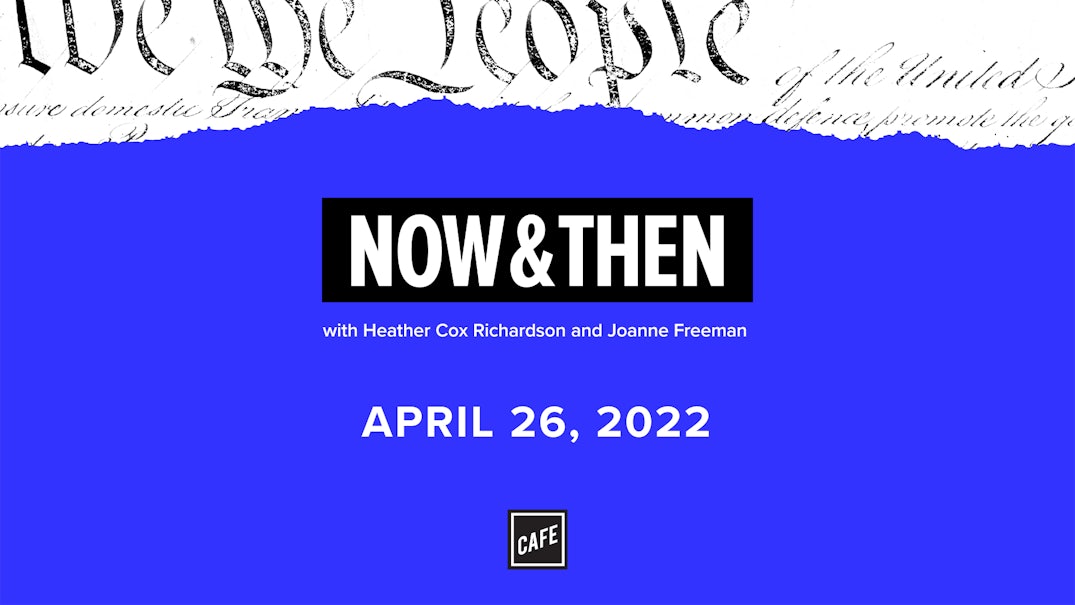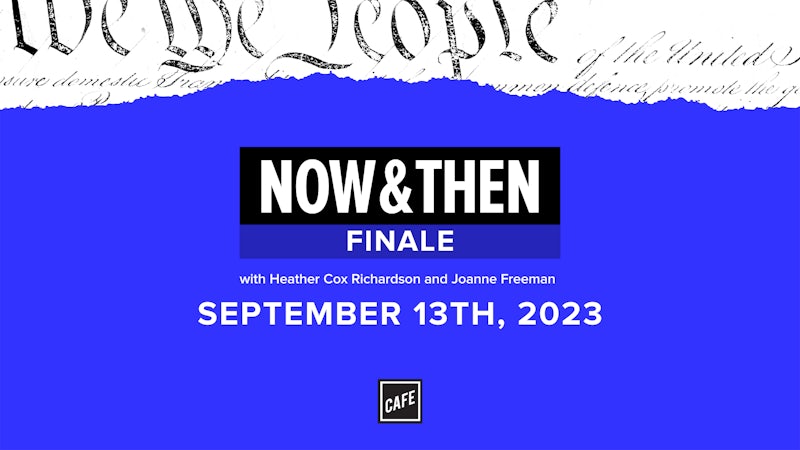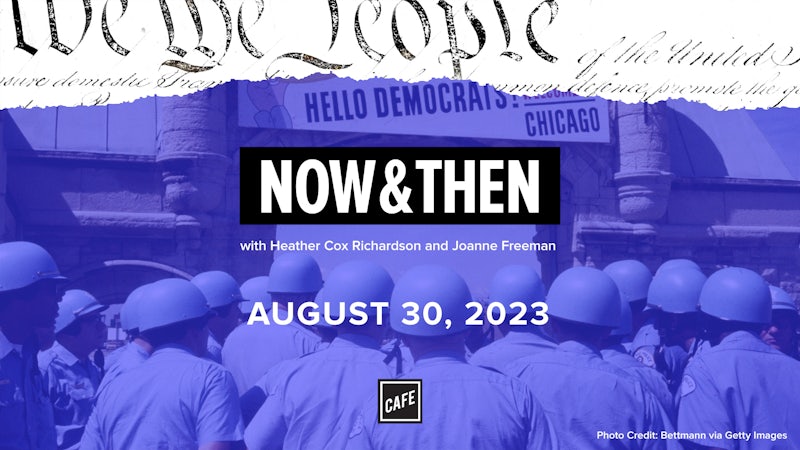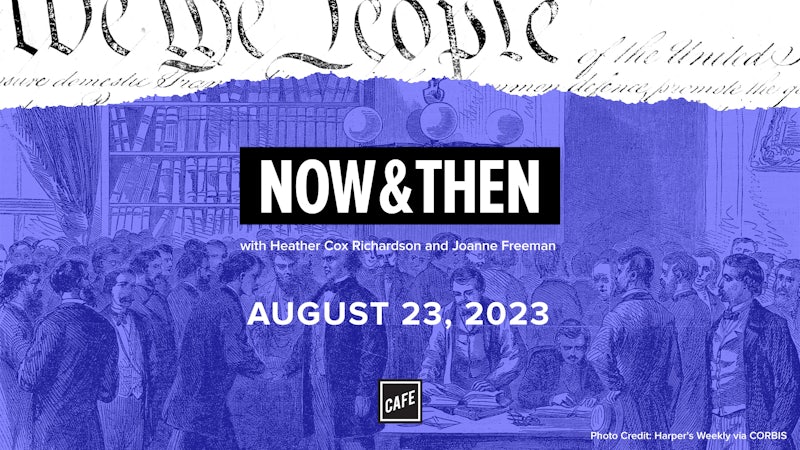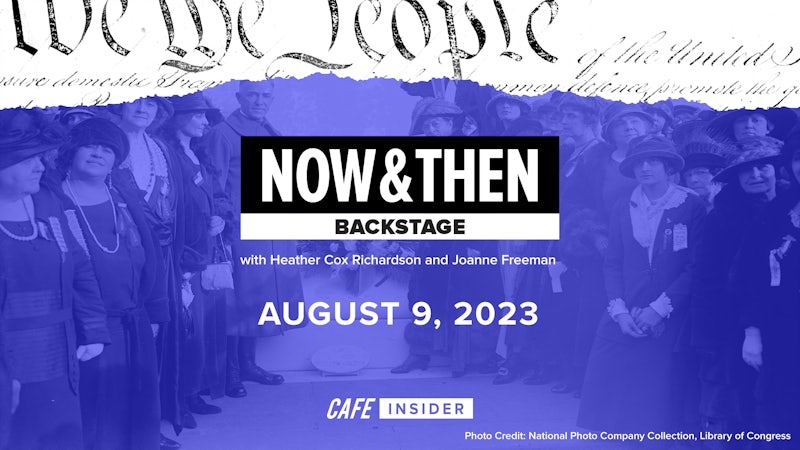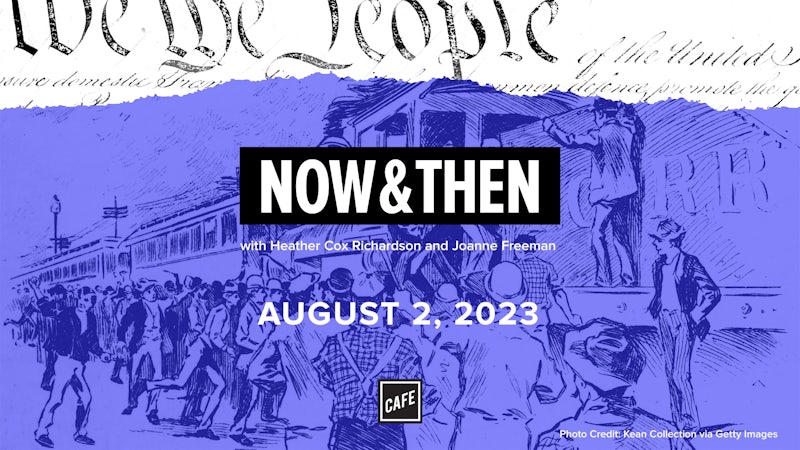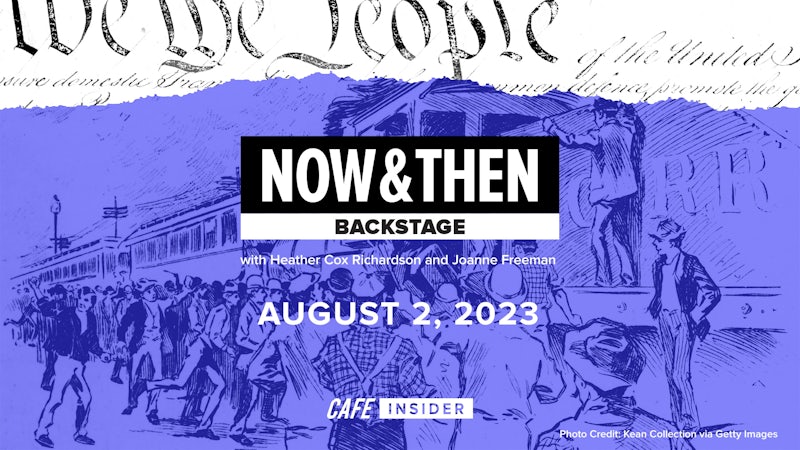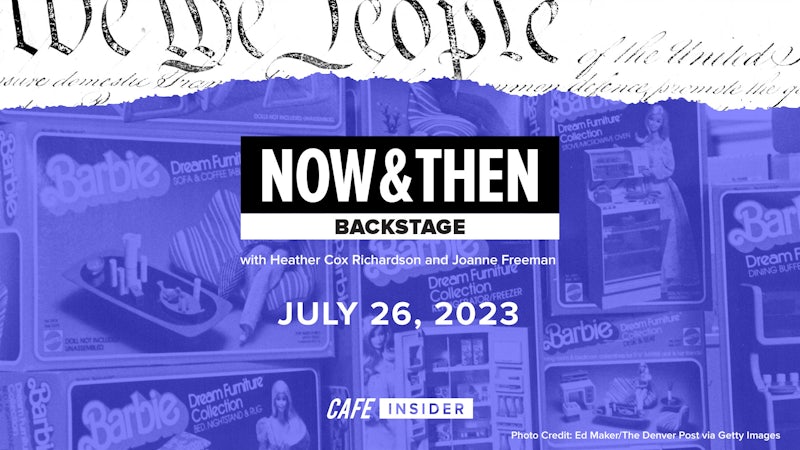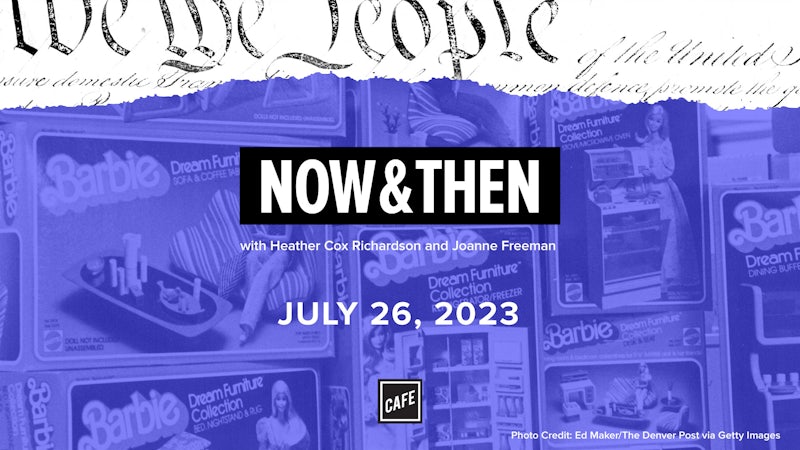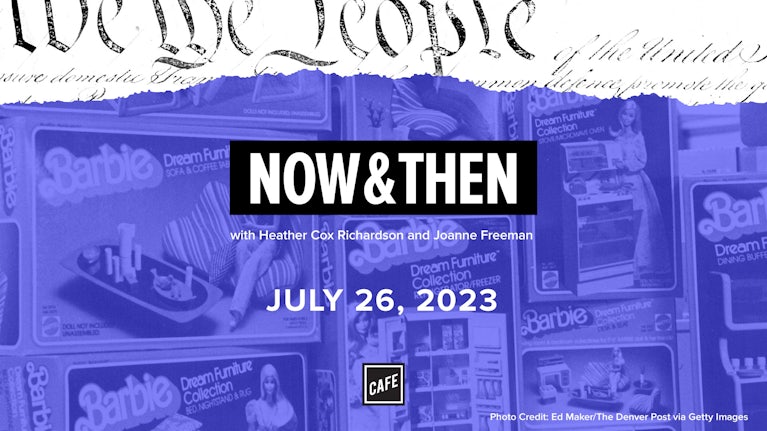Heather Cox Richardson:
From CAFE and the Vox Media Podcast Network, this is Now & Then. I’m Heather Cox Richardson.
Joanne Freeman:
I’m Joanne Freeman. Today we’re going to be talking about a topic that was inspired by something obvious. That is the fact that as we are here recording this episode, it is the week of Passover. We thought that what we would do particularly given that we have now the first known second family to host a Passover Seder at the vice president’s residence on April 15th, the fact that for that very reason, we have people thinking about the place of Jews in America and the place of Jews fitting within and being deployed by people in American politics.
We thought that that’s what we would address today. In one way or another would be not simply Jews in American history, but really more broadly than that, ways in which people have turned to the Jews, or looked at the Jews in a way that says something meaningful about American history, and may or may not say something meaningful about the Jewish people themselves.
We’re going to look through, as we always do, a wide lens over a broad sweep of time, and get a sense of how in American history the Jewish people, the collectiveness of the Jewish people, and the identity and stereotypes about some of the Jewish people have served a role, a political role, a social role, or a cultural role, and the ways in which that has and still today has meaning for people.
Heather Cox Richardson:
Before we get into the material that we wanted to talk about today, Joanne, I have to ask you to expound on something that came up while we were doing the prep here, because one of the things that we turned up was that the first known Seder in the White House, not in the second residency, but in the White House was under Barack Obama.
Part of the notes about that he talks about the importance of the story of Exodus to Americans, and so on. But one of the things that turned up was that in that ceremony, they used a certain document. I said to you like, “What is this? Is there some very special religious think tank that has given birth to this document?” You and all the other producers laughed, and said, “Oh, no.” Tell us about that document.
Joanne Freeman:
What I love about it is that you outlined it. You made it red. I’m like, “I have never heard of this temple.” Like, “How have I never heard of this temple?” Then you told me what it was. I’m like, “You’re kidding, right?”
Heather Cox Richardson:
I didn’t think about the fact that you thought it was a temple.
Joanne Freeman:
Okay. What we’re talking about here is the Maxwell House Haggadah. I just didn’t think you thought of Maxwell House …
Heather Cox Richardson:
What I was supposed to think?
Joanne Freeman:
Okay. The very quick version of the Maxwell House Haggadah, the reason I left and some of the producers laughed is because Maxwell House, the coffee-making company, made and has made for decades a Haggadah. The Haggadah is the prayer book that you use for a Passover Seder for the ritualistic dinner that you have either the first night or the first two nights of Passover.
There’s prayers and there’s songs and there’s ceremonies and there’s a big Seder play in the Maxwell House Haggadah has all of that in there. But it’s brought to you by the people of Maxwell House. Apparently they started doing this in the 1930s, were eager to appeal to the Jewish market. When you bought a can of coffee, you got to Maxwell House Haggadah with it. They’ve updated it over the years.
I think in my family, we probably had a version from the 1960s, I think, based on the cover and what I could pick up online when I looked it up. Some of the producers here who are, I shall say much younger than me, they also suggested that their family has the same bucket. Oh, Maxwell House Haggadah that you just pull out and grab for the holiday.
That is what this is that so stymied and that what I love about it, Heather, is that you had such a serious expression on your face. What is the Maxwell House Haggadah. I’m thinking like, “good to the last drop.”
Maxwell House Jingle (archival):
Maxwell House is coffee you can you count on. Maxwell House, good to the last drop. Maxwell House is? Good taste. Maxwell House is? A good feeling. Good to the last drop, Maxwell House. Maxwell House, coffee you can count.
Heather Cox Richardson:
Well, the irony is of course, I have a dear friend who studies classical religions and knows everything under the sun about it and is Jewish. I’m like for all of our discussions about this and the ancient Greek texts and the this and the that, how she never explained to me the religious group, Maxwell House. It’s a cup of coffee. All right.
Joanne Freeman:
One last thing though, and that is you brought up the story about in the White House how the Obamas use the Maxwell House Haggadah, and they got pushback because some people thought it wasn’t progressive enough, which indeed, it’s definitely not progressive. But I love the fact that there was pushback, when in fact, that’s the most traditional hugely widely used Haggadah. It’s, yeah, might not be progressive.
But most Jews would have the response that I had, and that some of our producers said, “Well, of course.”
Heather Cox Richardson:
Well, truly. I was looking at that and thinking they’re doing the first Seder in the White House. You’re going to get out the finest China, the most historic books, the whatever. That’s a good segue into the spin of American history on the history of Jews in this country. But let’s get then into one of my favorite pieces of early American history, and that is the continuation of an old biblical tradition on this continent.
Joanne Freeman:
It’s a theory that had a very long life over a period of centuries, people were talking about it. That is, I guess, what some people refer to as the lost tribe theory. What they’re referring to is the idea that there were originally 12 biblical tribes of Israel. That when Israel was conquered by the Assyrians in 721 BCE, 10 of those 12 tribes, either assimilated in or were forced out. In one way or another 10 of those tribes vanished, were lost. What happened to the lost tribes?
Over time, some people came to associate the lost tribes, with Native Americans in North America, and began to conjecture that these indigenous Americans were descendants of those original 10 lost tribes, that they were linked religiously, culturally, genetically to the original Jews. People were talking about that in the 17th century, in the 18th century.
There are books published about it of people basically trying in one way or another to tie Native Americans to Judaic tradition, and thus, in a sense, to the Judeo Christian heritage. Essentially taking a huge chunk of North America and giving it a history and ownership that could prove useful to Europeans or settlers, or colonists, who wanted those people to have a particular history that maybe changed the meaning of their place there and changed the meaning of the relationship of the colonists or the settlers to Native Americans.
I see you with a quizzical look on your face, Heather.
Heather Cox Richardson:
Well, not quizzical so much as I think that’s such an important point that it is a way to look at the indigenous people and their unique history and say, “Oh, no, no. They’re really not anything new. They’re really not anything unique to this continent. In fact, look, they’re just our history, but they’ve forgotten it. It’s a form of ownership of indigenous Americans, by reading onto them this biblical history, which I just find absolutely fascinating.
Joanne Freeman:
It’s amazing as is how appealing that was. I mean look, for example, at Cotton Mather, the New England Divine Colonial American, he wrote a book called “The triumphs of the reformed religion, in America. The life of the renowned John Eliot.” He’s talking about what Eliot believed. He says, “I confess, there was one” … I cannot call it so much guess as wish, wherein he was willing a little to indulge himself and that was that our Indians are the posterity of the dispensed and rejected Israelites, concerning whom our God has promised that they shall yet be saved by the deliverer coming to turn away ungodliness from them.
Here he’s saying, Eliot, maybe not a guess, but a wish he was hoping that the Indians were descended from the original Israelites. As you just said, Heather, that in that case, somehow or another, there’s some ownership there. There’s one God being referred to and endorsed by Native Americans and these colonists and settlers and onlookers from even from other countries, it’s a yearning.
That that would be in some ways convenient and revealing, and would bring native Americans into a story that maybe some of these people were more comfortable with.
Heather Cox Richardson:
Well, and the next piece of that, of course, is why does one care that these are the lost tribes of Israel? Because if in fact they are, that means the end times for the Bible are coming. That is something very welcome to the Christians who are eager to see America as God’s chosen land going forward. There’s this guy Elias Boudinot who writes about that. He is one of the founders and he starts the US Mint and later on he writes a book. The book is called A Star in the West, or a Humble Attempt to Discover the Long Lost Ten Tribes of Israel: Preparatory to Their Return to their Beloved City, Jerusalem.
It he says, “What could possibly bring greater declarative glory to God or 10 more essentially to effect and rouse the nations of the earth with a deeper sense of the certainty of the prophetic declarations of the Holy Scriptures, and thus call their attention to the truth of the revelation than a full discovery that these wandering nations of Indians are the long lost tribes of Israel, but kept under the special protection of Almighty God, though despised by all mankind for more than 2,000 years separated from and unknown to the civilized world.”
Joanne Freeman:
Just fascinating stuff. It’s important to note here that what we’re talking about isn’t just Christians looking on and offering this kind of identification. There’s a really interesting Jewish American in the 19th century named Mordecai Noah, and he’s a newspaper editor and he’s in the realm of politics. He’s a fascinating character, a writer. Mordecai Noah decides at one point in 1825, he wants to create a Jewish homeland, a Jewish colony on Grand Island, which is a little strip of land between Buffalo, New York and Canada and he wants to call it Ararat.
He wants it to be a kind of asylum where Jews could go. But he also wants Native Americans to help settle Ararat. Seneca chief Red Jacket actually is there for the opening ceremony of Ararat, which I will say does not last beyond a few years. But Noah, Jewish American, is very much part of this idea. He goes on electric tour and writes a book titled Discourse on the Evidences of the American Indians, Being the Descendants of the Lost Tribes of Israel.
He sees some shared heritage there. This is actually from his book that he ended up publishing in 1837. If these are the remnants of the nine and a half tribes, which were carried into a Syria and if we are to believe that all the promises of the restoration and the fulfillment of the prophecies respecting the lineal advent of the Jewish nation, what is to become of these are red brethren, whom we are driving before us so rapidly, that a century more will find them lingering on the borders of the Pacific Ocean, possibly the restoration may be near enough to include even a portion of these interesting people.
Our learned rabbis have always deemed it sinful to compute the period of the restoration. They believe that when the sins of the nation were atoned for, the miracle of their redemption would be manifested. But just as you said, there’s a linking of Native Americans being the last tribes to, I guess, the coming of the Messiah, the restoration, the holiest of holy moments coming in the new world.
Heather Cox Richardson:
Curiously, Joseph Smith, when he founds Mormonism actually sees this as a reason to work with indigenous people. He’s putting down the doctrines of Mormonism in the 1840s. But even as late as 50 years later, in the American plains in northwest, the indigenous tribes who go down to Salt Lake, for example, where the Mormons have settled are always astonished at how well-treated they are.
There’s at least one occasion where a group of Lakota have been warned not to go to Utah, not to go near the Mormons, because they would find them horrible people, the Indian agent told them that. When they go through, actually, the Mormons are incredibly nice to them, and feed them and talk to them and interact with them.
When the indigenous people go back to their agent, they write a letter saying, “We were told these people wouldn’t be very nice. But they’re really great people, unlike some people around here.” I’m paraphrasing. But they were able to actually turn that around.
Joanne Freeman:
This is a story of a variety of different kinds of people, using this myth of Native Americans as Jews for a variety of different reasons that are pleasing or useful. It’s a myth that lasts as long as it does, because it’s handy, and it invests some sense of ownership or some control over the narrative, or reinforces the narratives that these people want to tell.
It’s using the Jews associating them with Native Americans to create a narrative that they like. Now, that’s one very distinctive. You and I have both said interesting a lot of times, but that’s because it’s quirky and interesting, and it’s not necessarily commonly known. This leads us to a very different moment, as far as Jews in America is concerned. This is what follows a period leading up to the Civil War when there’s a really great influx of Jews into the United States.
In 1840, there were about 15,000 Jews in the United States. On the eve of the Civil War, there were 150,000 with immigration being led by Ashkenazi Jews from Germany. It’s a big influx of Jews. Many of them are involved in trading and textiles. Not surprisingly, with this influx of people from another country, and particularly a group that has a very collective group identity, and that stand out in that way see themselves as a group that leads to basically a lot of anti-Semitism.
Heather Cox Richardson:
That’s a really interesting place because the whole idea of war profiteering and the whole idea of using shoddy cloth, and that was a specific cloth that was actually cut off the remnants of bolts of fabric, and then essentially felted to look as if it were a new sheet of material that you would make uniforms out of it. But when they got wet, they fell apart. That was very much associated with the early years of the war.
They look at the war profiteering and the advent of things like shoddy cloth, and rather than saying, “Oh, this is John down the street who pulled this crap.” They read on to that, the old stereotypes that they are pulling from a long history of European tradition.
Joanne Freeman:
Which I actually will confess I did not know before this point. The word shoddy becomes anti-Semitic insult.
Heather Cox Richardson:
What comes from that, though, to me is interesting, because Ulysses S. Grant is a Union General. At the time in 1862, he’s in command of large swaths of Tennessee and Mississippi and Kentucky.
Joanne Freeman:
Ulysses S. Grant begins to hear word in around 1862 from generals, union generals, that there are cotton smugglers working with Jewish clothing manufacturers to move embargoed cotton from the south toward the union. Basically, that in one way or another, there are Jews involved with moving southern cotton. Obviously, this is not something that should be happening with around or for the Union army.
Heather Cox Richardson:
The movement of southern cotton is about money. The idea of making sure it can’t move means you’re going to be starving the south of money. The treasury secretary of the Confederacy is Jewish. This gets all tied up into the idea that somehow there are specific Jewish traders who are making it possible for the Confederacy to continue to fight because they are moving this cotton for them. Grant is unhappy with the idea that confederacy is continuing to fight, of course.
Finally, the final straw for him came in December of 1862 when he learns that there’s a Jewish family who is involved in a scheme to use Grant’s own father’s name in order to get a legal cotton trading permit in Cincinnati. They’re trying to actually draw him into this by using his father’s name to get a legal permit to move the cotton which the union government is trying to do.
On December 26th, 1862, he issues what’s called General Order Number 11. General Order Number 11 actually expels all Jewish people from his military district, which includes, as I say, Tennessee, Mississippi and Kentucky. The order reads, “The Jews as a class violating every regulation of trade established by the Treasury Department and also department orders are hereby expelled from the department within 24 hours from the receipt of this order.”
“Post commanders will see that all of this class of people be furnished passes and required to leave, and anyone returning after such notification will be arrested and held in confinement until an opportunity occurs of sending them out as prisoners unless furnished with permit from headquarters.”
Joanne Freeman:
Obviously, the striking thing there is the Jews as a class, violating every regulation of trade. Grant explains later and puts it in a way even more bluntly. He says, “That these regulations, these trade regulations are being violated mostly by Jews and other unprincipled traders, T-R-A-D-E-R-S. They come in with their carpet sacks in spite of all that can be done to prevent it. The Jews seem to be a privileged class that can travel anywhere. They will land at any wood yard or landing on the river and make their way through the country.”
“If not permitted to buy cotton themselves, they will act as agents for someone else who will be at a military post with Treasury permit to receive cotton and pay for it in Treasury notes which the Jew will buy up at an agreed rate paying gold.” Here, Grant is basically saying the Jews beam in and moved between the lines and do what they want and get what they want and they seem to have some privilege.
If you go back in time, and look at what people were saying like, “I hate to do this to you, but I love it too.” Jefferson, talking about women in the French Revolution, one of the things he says is “Women because they aren’t the standard bearers. They’re not the people in control of things, they can move between the lines. They can work around things. They can find their way into making trouble and do things nobody else can do.”
In a sense, that’s the logic here that Grant is using, describing the Jews, like Jefferson referred to women as a group, it’s present. They don’t have the rights of everybody else. They’re not really official power holders. For that reason, they can actually be more dangerous.
Heather Cox Richardson:
Well, maybe added to that the idea that there really is a problem with cotton trading. There really are bad people doing it. He reads on to that, “There are bad people doing this, therefore they must be Jews.” In fact, one of the major cotton traders, one of the most elite, major illegal cotton traders is actually a northern senator, who is not Jewish.
But Grant isn’t saying, “We got to get bad dude out of the senate.” He’s saying, “They must be Jews.” In fact, Jews in Holly Springs and Oxford, Mississippi, as well as in Paducah, Kentucky were ordered to leave immediately. Thirty men and their families actually got onto the Ohio River and moved from Paducah up to Cincinnati by riverboat.
But that’s not how the story turned out. A subset of the leading Jews from Paducah immediately wrote to Abraham Lincoln and said, “Hey, dude, what’s going on here?” They asked him to rescind the order. They connected it to other forms of global anti-Semitism. They wrote a letter saying, “The undersigned good and loyal citizens of the United States, and residents of this town” … That’s actually really interesting language because, of course, the Supreme Court had said that black Americans were not citizens with the Dred Scott v. Sandford decision of 1857.
Here they put right in front, “We our citizens, for many years engaged in legitimate business as merchants feel greatly insulted and outraged by this inhuman order. The carrying out of which would be the grossest violation of the Constitution and our rights as good citizens under it, and would place us besides a large number of other Jewish families of this town as outlaws before the world.”
“We respectfully ask your immediate attention to this enormous outrage on all law and humanity and pray for your effectual and immediate interposition.”
Joanne Freeman:
One of the letter drafters who is now an exiled Kentucky in June named Cesar Kaskel traveled to Washington, DC overland, to get a face-to-face meeting with President Lincoln. Kaskel was a 30-year-old Persian-Jewish immigrant, and a particularly respected one at that. He travels by steamer and does actually manage to get this face-to-face meeting in the Oval Office.
Supposedly, Kaskel later offered the story version of what happened when he met with Lincoln, almost sort of in the form of a little script. According to this anecdote, Lincoln says, “And so the children of Israel were driven from the Happy Land of Canaan.” Kaskel says, “Yes. That is why we have come on to Father Abraham’s bosom asking protection.” Supposedly Lincoln answers, “And this protection they shall have at once.”
Now, that does not read as something that really happened. It’s very biblical sounding. It cast Lincoln in the role of offering salvation to the Jewish people seeking from father Abraham some relief. Lincoln follows through and revokes Grant’s order. On January 21st, 1863, General Chief of the Army’s Henry Halleck writes to Grant explaining that rescinded order, explaining what Lincoln did.
Ironically in his explanation, using anti-Semitic tropes, Halleck writes to Grant, “The President has no objection to your expelling traders and Jew peddlers, which I suppose was the object of your order. But as it is in terms prescribed an entire religious class, some of whom are fighting in our ranks, the president deems it necessary to revoke it.”
Heather Cox Richardson:
What’s interesting is once the order is rescinded, the popular press largely at this point, abandons its anti-Semitism and it grabs on to Grant’s order, arguing that he had singled out a religious group and that was a major violation of the Constitution. The New York Times says, “Men cannot be condemned and punished as a class without gross violence to our free institutions. The immediate and peremptory abrogation of Grant’s order by the president saved the government from a blot and redeemed us from the disgrace of a military assault upon a people whose equal rights and immunities are as sacred under the Constitution, as those of any other sect, class, or race.
Joanne Freeman:
Now, it shouldn’t be surprising that Grant’s political enemies also use that order against him. In early 1863, Kentucky Democrat, Senator Lazarus Powell, argues that grants order was an affront to all religion. He says, “General Grant might just as well expelled the Baptists, or the Methodists, or the Episcopalians, or the Catholics as a class as to expel the Jews, all are alike protected in the enjoyment of their religion, by the constitution of our country.
That becomes a really handy tool to use politically against Grant. It comes back again during his presidential campaign in 1868 with prominent Jewish politicians and activists speaking out against General Order Number 11. Indeed, for the first time in American political history, Jews are seen as a significant voting bloc and newspapers begin to talk about the Jewish vote, begin to discuss trends and numbers as far as Jewish American voters are concerned, speaking of it, so it will be a deciding factor in the races.
It isn’t necessarily clear that that’s true. But it’s being discussed that way at this point in time.
Heather Cox Richardson:
Well, it’s important in part because the German vote in America in this period is staunchly Republican. To hit on the idea that he has been going after Jews who are mostly German Jews is a way to split that German vote.
Joanne Freeman:
Oh, for sure. Then you can hang the violating the constitution around his neck.
Heather Cox Richardson:
Especially with the Irish Catholic issue in New York and Boston, the idea of discriminating against certain categories of religion is very a really hot topic in this period.
Joanne Freeman:
Has a long history, but so on a bunch of levels. It’s just waiting there. Again, people can make use of this violation of Jewish rights for purposes that will serve them in this situation, in this case, political purposes.
Heather Cox Richardson:
I do like the way that this played out. I’m a huge fan of Grant. He clearly messed up. I loved his answer later on when people talked about this. Right before the election in 1868, in September of 1868, Jewish union veteran and an attorney, a man named Adolph Moses wrote to Grant to ask him what he was doing with that order, what he had meant and discussing the toll that the order had taken on the Jewish American community.
He writes, “I regret that our people who love to enjoy the quiet retreat of private life should be so prominently paraded in this campaign. But the instinct of self-defense presses utterance, however, unwelcomed the task. Our demands are simply to be judged like other people, and not to have the vices and shortcomings of our bad men illuminated at the expense of the many virtues and excellent qualities of our good men.”
Well, Grant decides that rather than making this public discussion, he’s going to write a private letter. He writes a private letter expressing regret for the order. He sends it to Congressman Isaac N. Morris, who’s a Jewish congressman from Illinois. Morris probably showed that around to other prominent Jewish leaders. After the election, Grant allowed it to be published. But he didn’t publish it beforehand.
I just love it because it’s so Grant. One thing about Grant is that he was willing to admit mistakes, and he was obviously an incredibly smart man, not only because of his military prowess, but remember, he basically starts the realist movement in American literature. He writes this letter and he says, “I do not pretend to sustain the order. The order was made and sent out without any reflection and without thinking of the Jews as a sect or race to themselves, but simply as persons who had successfully violated an order.”
“I have no prejudice against sect or race, but want each individual to be judged by his own merit. General Order Number 11 does not sustain this statement, I admit. But then I do not sustain that order.” Which I just liked.
Joanne Freeman:
He made a mistake.
Heather Cox Richardson:
Yeah. I screwed up.
We’re using a Jewish experience to define America in the early years. Now, we’re using how Grant used stereotypes to make really sweeping, biased orders during the Civil War and maybe learn from him.
Then honestly, when we talked about this topic, this is the piece that most interested me.
Joanne Freeman:
It has a deep meaning to me, too. As we plunge into it, though, I do want to make the point that we are in one way or another talking about people deliberately or unconsciously constructing narratives involving Jews for some explicit purpose. We are looking at Jews in American history. We are looking at ways in which Jews are intimately interwoven with what’s happening.
But we’re also looking at the ways in which the Jewish story ends up being used in a variety of different ways throughout American history to make bigger points. That’s certainly the case with what we are now going to move on to discuss, which is Anne Frank’s diary. Anne Frank was born in 1929 in Frankfurt. She moved as a toddler to Amsterdam with her parents, her father, Otto; her mother, Edith; and her older sister, Margot.
The Nazis invaded the Netherlands in May of 1940, when Anne was 10. Over the next two years, she would see the escalating control of the Nazis and the variety of public humiliations that they would heap on the Jews that ultimately would lead to genocide. She got a diary as a 13th birthday gift, just before she and her family went into hiding in a secret room of her father’s business annex.
Over the course of the next two years, when she and her family were in hiding, she was writing in this diary. When you and I were talking about this before, Heather, we were both talking about the fact that just regardless of the historical circumstances, or in anything else about the diary, she is a really gifted writer. She wanted to be a writer. You can see that she really is a writer.
For those of you out there who’ve read the diary, you can see it. It makes it all the more, on the one hand, tragic that she didn’t live to get to the point where she could see herself as a writer and that in fact, she did become a very well-known public writer in ways that she never could have anticipated.
Heather Cox Richardson:
That gives me such enormous pleasure that she is one of the most famous writers of the 20th century. That feels at some level cosmic justice that they tried to silence her. Instead, they made her one of the most profound writers of not just her generation of a century.
Joanne Freeman:
She’s writing this diary over the course of two years as she hides. But in a sense, I suppose, no diaries ever finished, but hers is particularly unfinished, because on August 4th, 1944, the Nazis discovered her family’s hiding spot, and she was sent to Bergen-Belsen, where she died of typhus around February 1945. She was about 15 years old.
For time, her diary is discovered, and it’s put away and after the war, her father ultimately recovers the diary with the help of those who were hiding the family. The diary is published in Germany, and then in the Netherlands, where by 1950, the book had sold 25,000 copies. IT’S also published in France. But this brings us to a really interesting moment in the story, again, in a way we’re talking about narratives, people using the Jewish narrative in a variety of different ways.
Anne Frank’s diary is all about narrative. It’s her narrative and her story of her experiences. It ends up being a story that her father, when he has the diary published, he edited and changes it for a variety of different reasons, some of them personal. Then as we’re about to discuss, it becomes a narrative that finds its way into a play, finds its way into film. There are critics who comment on the many ways in which her narrative has been used and deployed, and some might say warped for purpose.
Here, we’re looking at the ultimate use of a Jewish story and really this ultimate hard Jewish story of the Holocaust being used in a variety of different ways, with very different impacts and all of these different ways. An extreme example of what we’re talking about throughout this episode.
Heather Cox Richardson:
Well, it’s a much grander story even than that, in that what we’re really talking about is the degree to which her story is personal. It’s a personal story of a Jewish girl. At the same time, it is universal. Where is there overlap and where are you being true to the voice of the person and were you being true to the principles behind that. At what point can you take that aspect of who somebody is and say, “Well, really, it’s a universal story, because in this case, in many ways, it’s not a universal story. But in America, we know it as a universal story.”
I’m fascinated by that, because of the interplay between our many different histories in America that I would like to argue makeup one history. But there’s some ways in which the black experience is not a universal experience. There are other ways in which it is and same with immigrants, same with disabled, same with women’s.
Joanne Freeman:
Right. Any population. It is not universal. The fact that it’s not universal matters enormously to the people you’re talking about and to the larger story, because if they do indeed come together as a story, that’s a story of differences coming together into one story. It’s the fact that these are different groups coming together with their own identities of their own histories. That’s what makes it so meaningful when they come together.
Heather Cox Richardson:
Yet, it is completely legitimate to say, “Get your hands off my story. You’re not accurately representing me by turning this into as people felt happened with the Anne Frank story, a feel good story, because it wasn’t a feel good story. Lots of people died in really horrible ways.”
Joanne Freeman:
There all kinds of reasons why, in different circumstances, different kinds of people, really, the diary resonates with them. Whether that means teenagers, young girls, particularly who can feel in her some of the rebelliousness and insecurity and desire for more than they have, or people who feel repressed in some way or held back or are afraid of being oppressed, and see her as a reminder of how important it is to resist, or Jews looking at her as an example of the suffering of the Holocaust and the ability to stand up to it, even though ultimately she had to succumb to it.
I mean, there’s so many ways in which you can find your way into meaning in that diary. To me, I would say, a teenager reading and saying, “Yeah.” I see myself in her because she’s this young woman who is just so focused on what she needs at this particular moment. I can feel her yearningness. On the one hand, that’s true. On the other hand, as a Jew, my response to that is, “But it isn’t just a young girl. It’s a young Jew who is hiding because she’s afraid her family will get killed.”
You can totally see the many levels on which this can be profoundly compelling as a diary. The ways in which as you just said, different people have every right to say, “No. You can’t use that story that way. It has a different meaning and in some ways, a deeper meaning, when it’s put in its historical context.”
Heather Cox Richardson:
Well, the mark of a great piece of literature, too. I mean, that’s the one of the things that really stands out about it. Let’s walk through how the diary gets a life of its own in America. It had been published in Germany. It had been published in the Netherlands. It had been published in France. It had sold, well, 25,000 copies but was not yet a blockbuster.
A Jewish American novelist and a reporter, a man named Meyer Levin that became one of the diary’s biggest champions in America. He had seen the horrors of the Holocaust at firsthand because he had been a correspondent with the 9th Air Force and the 4th Armoured Division.
He had been present at the Allied liberation of Buchenwald, Dachau in Bergen-Belsen, which is of course where Anne Frank had died. He read the French edition of the diary in 1950. He tried to buy the American Literary Rights and he was not able to do it. But he began to work with Frank’s father, Otto Frank, to sell the book to Doubleday.
They sell the book to Doubleday in 1952. He writes a review of the book in The New York Times, where he highlights just how universal Anne Frank’s words were. He wrote, “There is no lugubrious ghetto tale, no compilation of horrors. Reality can prove surprisingly different from invented reality. Anne Frank’s diary simply bubbles with amusement, love, discovery. It has its share of disgust, its moments of hatred, but it is so wonderfully alive, so near that one feels overwhelmingly the universalities of human nature.”
“These people might be living next door; their within the family emotions, their tensions and satisfactions are those of human character and growth anywhere.” He goes on to stress and her incredible talent and how her senseless killing was reflective of the sheer beauty of humanity despite genocide.
He said, “There is an anguish in the thought of how much creative power, how much sheer beauty of living was cut off through genocide. But through her diary Anne goes on living, from Holland to France, to Italy, Spain. The Germans too have published her book. And now she comes to America. Surely she will be widely loved for this wise and wonderful young girl brings back a poignant delight in the infinite human spirit.
Yes. It does seem rather that there’s something missing in his description of not only the diary, but the circumstances under which the diary was written. Of course, what happened to her, it almost feels as if she never died?
Joanne Freeman:
Well, right. Talking about universalizing it or focusing on the human spirit component of it, in that sense, you can say, “Yeah. That perhaps she didn’t die.” I’ll read here the quote that people always quote, I actually, since we’ve been talking here, I believe I even had it up on the wall of my bedroom when I was a kid, a little poster of it, the quote goes, “In spite of everything, I still believe that people are really good at heart. I simply can’t build up my hopes on a foundation consisting of confusion, misery, and death.”
It’s that first line, “In spite of everything, I still believe that people are really good at heart” that gets quoted again and again. That Levin here is referring to. It’s remarkable that she is saying that in this diary, written under those circumstances, and she doesn’t know this necessarily at this point, but as doomed as she is. Now, what’s interesting is when you actually go and read the diary.
On the one hand, she does say that, and it’s remarkable that she says that. But she says other things, too. For example, towards the end of her time in hiding, she writes, “What will he do if we’re ever … No, I mustn’t write that down. But the question won’t let itself be pushed to the back of my mind today. On the contrary, all the fear I’ve ever felt is looming before me in all, its horror.”
“I’ve asked myself again and again whether it wouldn’t have been better if we hadn’t gone into hiding. If we were dead now, I didn’t have to go through this misery. Let something happen soon. Nothing can be more crushing than this anxiety. Let the end come, however cruel.” A few days later, she added, “We are Jews in chains.” Now that’s very dark. It makes sense that it’s very dark.
It’s another tone within that diary that of course has to be there because of what it is, the circumstances that she’s under, the different things she’s experiencing, and what she has to be thinking. On the one hand, it makes perfect sense for that quote about believing that people are really good at heart to resonate and to sing, and to live on beyond the diary. But it doesn’t do justice to the diary, the circumstances, or Anne Frank all told, right.
It’s an example of part of it being so profoundly moving in so many ways. But it’s not reflective of the whole and there are other aspects of it that could be and are just as profoundly moving to other people. As you said a moment ago, Heather, it’s as with any great piece of literature, it has multiple voices and multiple messages that can speak to many different people.
But in taking the story and making it one that’s about the singing of the human spirit, that can be really problematic if you’re talking about the Holocaust.
Heather Cox Richardson:
Well, it’s just like you say, it’s a moment that speaks to America in 1952 rather than that speaks to the experience of Anne Frank. Levin loved this diary. He went on to try and acquire both the stage and the film rights for it and began to work on a play. As he is working on it, and as her story is taking off, he begins to become more and more uncomfortable with how it is being universalized and how it is being looked at as some … as he said, “Bubbly version of the life.”
He begins to have business disagreements with Anne Frank’s father, Otto Frank, who said that, “Your play is getting too dark. It’s getting too serious and non-Jewish-Americans aren’t going to be interested and aren’t going to watch it.” Otto Frank goes to a different playwright team, a husband and wife playwright team, the Frances Goodrich & Albert Hackett. They were best known for uplifting screenplays for things like The Thin Man or Easter Parade and even It’s a Wonderful Life.
When that happens, Levin gets very unhappy about Frank’s decision and he judges it really harshly. He accuses another playwright, Lillian Hellman, of having intervened on behalf of Goodrich and Hackett. He accuses Hellman of an anti-Semitic plot against him. Finally, he starts a multi-decade legal battle with Otto Frank, claiming that Frank has sold out his daughter’s legacy. Very sad story, I think, no matter how you look at it.
But in any case, when the play comes out, it’s the Diary of Anne Frank. It opens on Broadway on October 5th of 1955 and plays to full houses, gets rave reviews, wins the Pulitzer Prize, major theatrical awards, and runs for 717 New York performances.
Joanne Freeman:
He’s initially grabbed by that larger universal human spirit component of the diary. But what he ultimately zeroes in on is the Jewish component of it as well, which is precisely what drives what you’re just describing. I think you can see dramatically the difference between ultimately his take on a public presentation of the diary and the final one that wins the prize with just a brief little quote. The prize winning version of the play has Anne Frank pronounced at one point, “We’re not the only people that have had to suffer. There have always been people that have had to, sometimes one race, sometimes another.”
Talk about universalizing. Levin, in his version has Anne Frank, say, “Who has made us Jews different from all other people? Who has allowed us to suffer so terribly till now? She goes on in that vein. That’s dramatically different. The play version, the Goodrich, Hackett version, almost can’t be more universalized than that. You can see why Levin would have been so displeased with that, just even comparing it with that simple statement, but yet a very clear statement, which has to do with Anne Frank, the Holocaust, and the Nazi attack on Jews.
Heather Cox Richardson:
Well, you can see why the playwrights decided to go with that, too, in 1955, which is right after Brown versus Board of Education, and right when the attacks on desegregation are heating up so in America, that they probably were concerned at the idea that they would not get the kind of universal audiences paying attention to the existence of this diary from the Holocaust, which to them was in the rearview mirror compared to the extraordinary attacks on black Americans in the United States in 1955.
Joanne Freeman:
But again, precisely, by using that story in this way, and weaving it into this kind of narrative, the more universalized narrative. Again, it’s the Jewish story, having a power and an appeal that matters at that moment, it’s just a very particular version of it. She says … When I was reading through parts of it, in preparation for this episode, I saw these lines in a way they combined both sides what we’re seeing here.
She writes, “I see the world’s being slowly transformed into a wilderness. I hear the approaching thunder that one day will destroy us, too. I feel the suffering of millions.” I read that and thought, “how current and how immediate that feels,” even though she’s, again, speaking of the Holocaust. She then says, “In the meantime, I must hold on to my ideals, perhaps the day will come when I’ll be able to realize them.”
There it is. As of the moment, she’s acknowledging the suffering and the pain and the darkness and acknowledging that ideals can and do exist, and are out in the world and matter. In a way, her story is used in different ways. We could have a really long and interesting conversation about what we feel about that because I end up feeling conflicted in some ways, too, probably slightly different from you.
But I just love this work in and of itself and it’s amazing to talk about it. But in a way, it’s kind of fitting to move towards the end of our episode, by giving her the last word, because what she’s basically saying in that quote, is the story I’m telling, the story of my moment, and the story of the Jews in this moment, it’s dark, and it’s ugly, and it isn’t over, and we still have ideals.
We’ve talked throughout this episode, about, on the one hand, the Jews being present within American history being interwoven with it, of course, being used in different ways, in different narratives for different purpose, at different moments in American history, coming forward themselves at various points to express that they’re being mistreated or misunderstood.
In the end, all of that is true remains true, I think in a way, many groups that we now called marginalized groups end up being used by larger populations for this kind of purpose. But the fact of the matter is they’re here and they have their own voice. She has her own voice. It’s a voice that can be both universal and personal, and historical, and dark and light at the same time.












